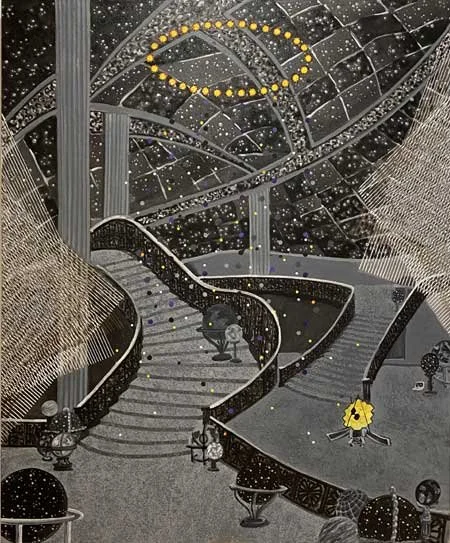“Michiko Itatani: Celestial Stage” An Exhibit at Wrightwood 659
“Distant Earth & Moon” painting from Infinite Hope 22-C-2
Michiko Itatani: Celestial Stage, an exhibition featuring works by the Chicago-based Japanese artist, began on Oct. 1 at Wrightwood 659 in Chicago.
Presented by Alphawood Exhibitions, the exhibition displays more than 60 artworks created by Michiko
“Shadows of the Mind” painting from Celestial Connection 18-B-4
Itatani, Professor Emeritus at the School of the Art Institute of Chicago (“SAIC”). Her cosmic-themed paintings and drawings are divided into three sections and can be viewed on the third and fourth floors.
As many of them feature winding staircases, globes in various sizes, and glowing lights, the works are visual representations of the artist’s life-long fascination with the unknown universe and the humility and glory of human endeavor.
“My paintings are about human existence in the larger context of the universe,” the artist explained at the Gallery during the opening event on Oct. 13. “While we are making significant achievements [in our history] . . . I have been disturbed by serious and urgent situations on the earth, which humanity is mostly responsible for.”
Photo left: Michiko Itatani and her work “Collection Sol III” painting from Celestial Maze 22-B-1
Itatani, originally from Osaka, Japan, has taught at the SAIC for 40 years. Her work is part of the permanent collections at museums around the world, including the Barcelona Museum of Contemporary Art in Spain, the National Museum of Modern and Contemporary Art in South Korea, the Olympic Museum in Switzerland, the U.S. Embassy in Brazil, and the Art Institute of Chicago. Her cosmic murals also decorate the CTA’s Washington station.
Itatani said most of the paintings on display were made during the pandemic isolation.
“‘Infinite Hope’ is the main theme of the 3rd floor [exhibits],” she continued. “. . . I have been trying to sustain ‘infinite hope’ through the painting process. The unattainable desire to know the unknown kept me from losing hope.”
Her works on display – many of them 7 x 8 feet or larger – are more powerful when seen on site than in print and grab the viewer with their energy. Viewed in person, they also emit intimacy, as if they invite the viewer into the vast cosmic world depicted on the canvas.
Itatani’s artwork seems to consist of subtle codes and symbols. Appearing repeatedly in her canvases are wide, asymmetrical staircases that lead to a balcony. Sometimes they ascend toward an endless stretch of dark, starry sky. They seem to invite the viewer into an infinite search of the secrets of the universe.
Musical instruments such as grand pianos, harps and cellos, as well as rockets and terrestrial globes, litter her dense tableau, hinting at humanity’s cultural and scientific achievements. Depicted in some of the paintings are spaces that look like a Japanese tea room, with vertical sliding doors and decorative openwork panels above them. They seem to be a wink at tea ceremony and traditional Japanese culture, which Itatani is known to love.
Photo right: “Cosmic Returning” painting from Quantum Chandelier 21-D-02
In her youth, Itatani wanted to become a fiction writer. She still believes in “fiction’s ability to tell the deepest truth.” “Here, I am sharing my fiction in the painting language; I’d like to invite viewers to participate in my fiction and draw different conclusions,” she said.
The exhibition’s 80-page catalog includes a short fiction written by Itatani. Told in a first-person narrative, the story depicts a strange world of cosmic library, into which “I” step led by mysterious rings of light.
From a large, empty hallway, “I” climb up a grand curved staircase which leads to an enormous library. Its shelves are filled with countless books. “I” open some of them but none are comprehensible, some with images of geometrical patterns and others printed in a strange language.
“I” climb more staircases and go through more libraries, all the while looking up at the misty dorm-like ceiling, through which a dark, starry sky is visible.
When “I” reach the top floor, an odd little person, who looks “not very young,” appears. He explains that he and others came from far away, a long time ago, and decided to create a library so anyone can have access to “vast and scattered information” in the cosmos.
Photo Left: “Lagrangian point 2” painting from Infinite Hope 22-C-5, Photo right: “Untitled” painting from Radiant Triage 04-C-2 (RT-2)
The story is an accompaniment to Itatani’s artworks on display, or, conversely, they are the visualization of her cosmic imagery expressed in written words.
Up close in person, a visitor to this exhibition can examine at first-hand Itatani’s drawing and painting techniques in detail. From preparing a canvas to painting, she does it all by herself. “On the surface of a canvas, nothing exists unless I paint it. This lonely process is still my way of making art,” she said.
Wrightwood 659 is a remodeled brick building with a five-story atrium, designed by famed Japanese architect Tadao Ando.
Concurrently on view at the gallery is The First Homosexuals: Global Depictions of a New Identity, 1869-1930 on the second floor, a “groundbreaking exhibition” developed by a team of international scholars.
*************************************************************************************
Michiko Itatani: Celestial Stage
Oct. 1 – Dec. 17
Fridays, 12 pm - 7 pm
Saturdays, 10 am – 5 pm
Admission: $15
Tickets can be purchased online only at: https://tickets.wrightwood659.org/events






